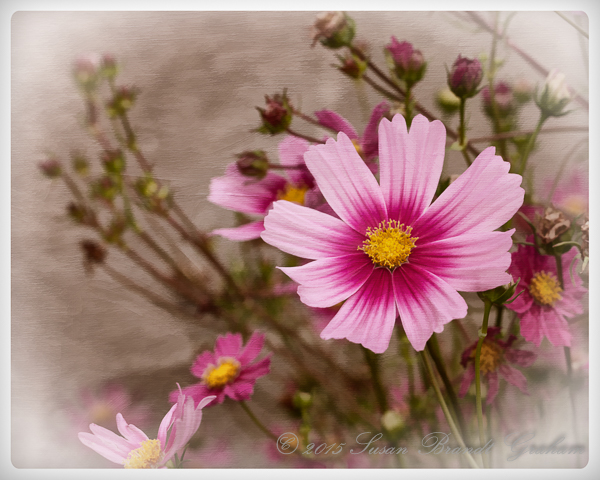Cosmos

Cosmos
Cosmos is an annual I grow every year, not only for the beauty of the flowers, but also because the goldfinches and hummingbirds like them. When the seeds develop, the goldfinches prefer them to the nyger seeds I usually provide. For that reason, I do not deadhead these flowers, even though I would get more blooms if I did. I grow them, enjoy them, and then enjoy watching the birds feed on them.
Several days ago I posted some images from my garden, images with no editing (to say nothing of enhancements!) except for cropping and placement of a watermark. That was something of a photography exercise for me. Although I was not unhappy with the outcome, I personally found the exercise itself to lack the “fun” I find in digital photography. Last evening, for the first time in some time, I had a couple of hours to do what I enjoy – manipulate a photograph to create an image that reflected something more (to me, at least) than “a real flower captured by the camera.” What you see is the result.
I firmly believe that developing a raw file is something absolutely necessary to realize the full potential of digital photography, and should always be allowed.
“Enhancing” a photo through the use of many techniques, as this image has been enhanced, is very different from editing a raw file to develop it. I think any discussion of what should be allowed for any given use of an image should clearly distinguish between “editing” to develop a raw file, and “enhancing” to create an image not captured on a sensor.
Back to cosmos – a wonderful annual for its inherent beauty, and as a natural “feeder” for birds. A good flower for the garden in the desert southwest.



When you have the resources to enhance you images, do it. I think there is a real lack of creativity and a lot of laziness involved with the idea that you have to use what comes straight off the camera without even making adjustments to a raw image. That would be like a painter trying to make a painting from only where the paint falls on the canvas (there are few Pollocks among us) and the first brush strokes are laid down, and then thinking that’s it, because going back and adding more brushstrokes would be cheating.
I never even considered deadheading cosmos. Hmmm! Our cosmos are starting to bloom and will soon have an explosion of blooms from our forest of cosmos.
I love the image you produced. It has many layers that give it a 3D effect popping the right out of the frame.
Hi, Tim. I really like the analogy you make with painting. To be honest, I had never thought of it in quite those terms. I like the way you phrased the issue.
The first year I planted cosmos I was all set to deadhead. Then I saw all the birds. Just ignorance. I learned before any harm done. 🙂 )))))))))
Thank you especially for the comment on the image. I had a lot of fun!
Your commentary on your images inspires me to better myself in the photography arena. A class , perhaps!?
For the first time, I have quite a few sunflowers in my yard. Observing the goldfinches pecking at the leaves is very entertaining. In looking up “small birds + sunflower leaves” I found that the goldfinches are actually eating the leaves, not just destroying them or getting bits for nesting! So I am leaving my sunflowers up til they topple!
Hi, Laurie! Aren’t our birds and flowers here wonderful? I had actually planted both my cosmos and sunflowers at the “right” time this year. A couple of weeks ago the sunflowers, past their prime by now, were looking pretty dismal. I cut off the seed heads that still had seeds, and put them where the birds could eat them. Then I pulled out the stalks and planted a new set of sunflowers. I’m thinking they should be in full bloom during our glorious fall days. I am so glad you are enjoying your sunflowers and birds!
If you do decide to take a class, I can definitely recommend the digital photography program and UNM Continuing Education. I thoroughly enjoyed my time there!
Thanks for stopping by today. 🙂